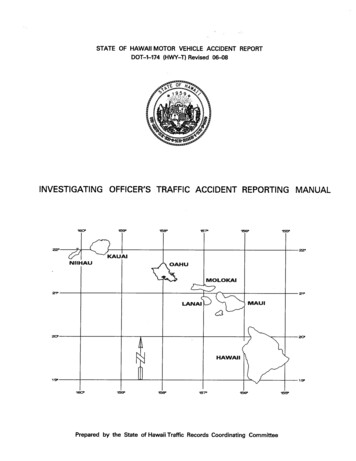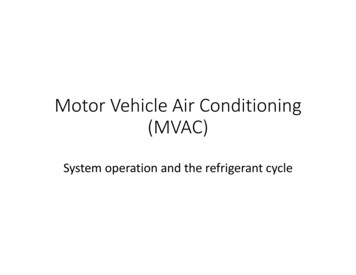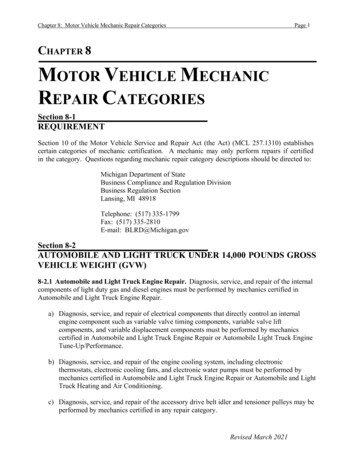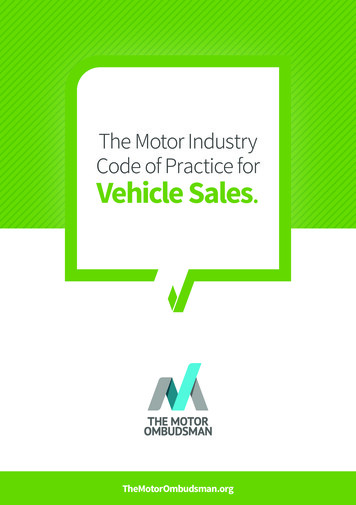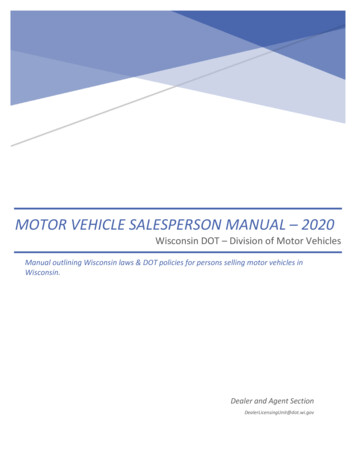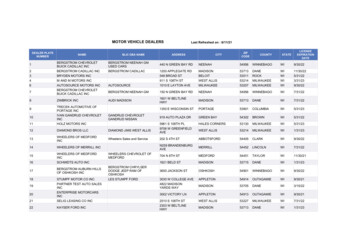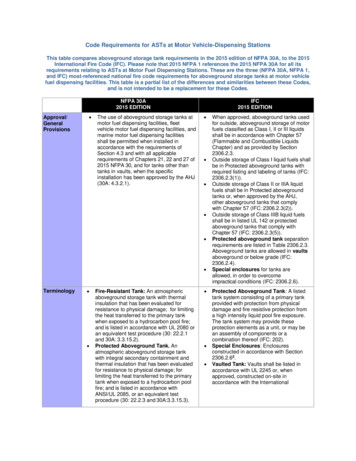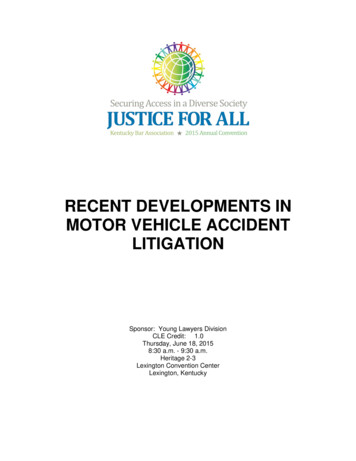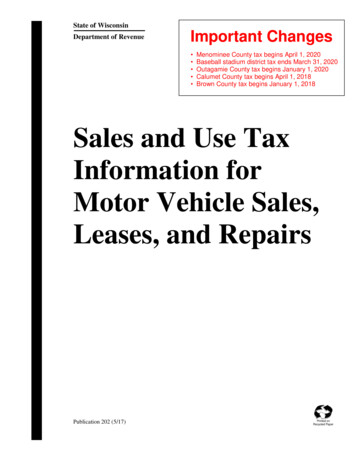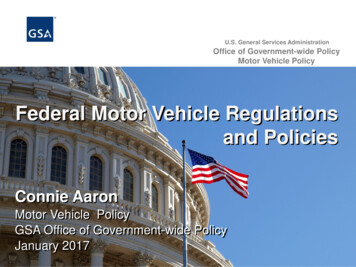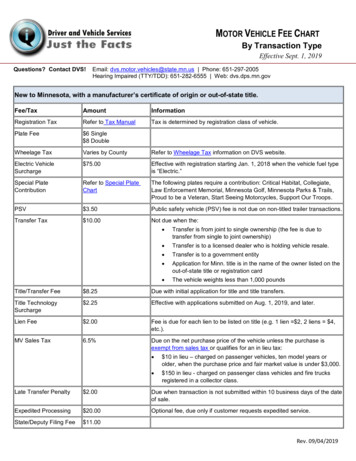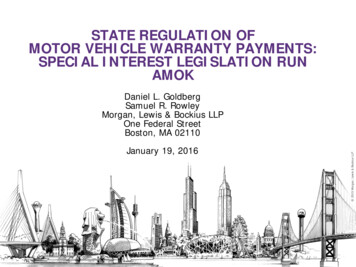
Transcription
STATE REGULATION OFMOTOR VEHICLE WARRANTY PAYMENTS:SPECIAL INTEREST LEGISLATION RUNAMOKJanuary 19, 2016 2015 Morgan, Lewis & Bockius LLPDaniel L. GoldbergSamuel R. RowleyMorgan, Lewis & Bockius LLPOne Federal StreetBoston, MA 02110
AuthorsDaniel L. GoldbergPartner 1.617.951.8372daniel.goldberg@morganlewis.comOne Federal StreetBoston, MA ldbergDan Goldberg is a partner with Morgan Lewis. He has a broad commercial litigation practice with afocus on antitrust, franchise, and intellectual property cases, and tries cases and argues appeals incourts around the country. He has more than thirty years of experience representing motor vehiclemanufacturers and distributors, acting as lead national and regional litigation counsel in numerousfranchise matters, and as lead counsel challenging the constitutionality of state franchise laws inFlorida and Connecticut. He is a Fellow of the American College of Trial Lawyers.Samuel R. RowleyAssociate 1.617.951.8692samuel.rowley@morganlewis.comOne Federal StreetBoston, MA wleySam Rowley is an associate with Morgan Lewis. He represents clients in a variety of complexcommercial matters, including antitrust, franchise, and financial restructuring litigation in courtsaround the country. He has extensive experience representing motor vehicle manufacturers anddistributors in a variety of matters, and has been a core member of the Morgan Lewis teamchallenging the constitutionality of state franchise laws.Although the authors have a long history of representing motor vehicle manufacturersand distributors, this presentation is not submitted on behalf of any client.2
Historical Disparity in Bargaining Power:The “Rationale” of StateMotor Vehicle Franchise Regulation State regulation gained impetus in themid-twentieth century on the heels of federallegislation. Then a few large manufacturers withconsiderable financial resources accountedfor the vast majority of new motor vehiclessold in the U.S. The typical motor vehicle dealer was a smallbusiness with limited financial resources.3
1978: SCOTUS Upholds Cal Law inNMV Board v. Fox “The disparity in bargaining power betweenautomobile manufacturers and their dealersprompted Congress and some 25 States to enactlegislation to protect retail car dealers fromperceived abusive and oppressive acts by themanufacturers.” Purported bargaining power disparity continues toserve as support for dealers’ claim that they needstatutory protections from the conduct ofmanufacturers – despite significant changes in theindustry.4
The Relative Bargaining PowerHas Changed Dramatically Changes are primarily threefold: Increased competition among manufacturers both for retail salesand for good dealers – competition that requires manufacturers todevelop strong dealers to compete with other brands for retail sales.Interbrand competition among manufacturers, and reliance ondealers to sell their vehicles at retail, provides market incentives toensure dealers are properly incentivized. Increased dealer scale and scope has significantly changed relativebargaining power; large dealer groups, not mom-and-popbusinesses, are the entities with whom manufacturers mustnegotiate. Dealer protection legislation, developed and supported by politicallypowerful dealers and dealer associations, provide broad protectionagainst bad faith and unreasonable conduct.5
The OEM Landscape HasChanged Dramatically: Increased Competition 1965: “Big Three” accounted for more than 90% of newmotor vehicle unit sales in the U.S.; GM alone was close to50% 2014: “Big Three” accounted for only 45% of unit sales Toyota, Honda, and Nissan accounted for 32% of sales,with other imports accounting for 20% 2009: GM and Chrysler bankruptciesSource: WardsAuto Group Report: U.S. Vehicle Sales Market Share by Company, 19612012; NADA Data Reports, Market Share 2005-2014, nada.org6
The Landscape HasChanged Dramatically7
The Dealer Landscape HasChanged Dramatically 1986: Average dealership sold 649 new vehicles;generated 10.8 million in revenue; secured less than 250K in pre-tax profit 2011: Average dealership sold 793 new vehicles;generated 38 million in revenue; secured 870K in pretax profit 2014: Average dealership sold 1,003 new vehicles;generated more than 49 million in revenue; securednearly 1.1 million in pre-tax profitSource: NADA Data Reports; available at NADA.org8
The Dealer Landscape HasChanged Dramatically9
The Dealer Landscape HasChanged Dramatically 1960: No dealer appeared on Fortune 500 list. 2015: AutoNation, Penske, Group 1, Sonic, Asbury,and Lithia rank in the Fortune 500, each generatingbillions in revenue, with hundreds of dealerships inthe U.S. Bargaining power of the large dealer groups benefitsall dealers because manufacturers generally adoptuniform dealer policies.10
The Dealer Landscape HasChanged Dramatically11
The State Regulatory Landscape HasChanged Dramatically Today, nearly every facet of the manufacturer-dealerrelationship is subject to varying degrees of stateregulation across all 50 states. Wide ranging protections against bad faith,arbitrary and/or unconscionable OEM treatment ofdealers. Among other statutory protections, dealers areprotected from (i) competition by direct sales; (ii)termination, (iii) appointment of same-line makecompetitive dealers, and (iv) all variety of“unreasonable” activities by OEMs, and . . . Dealers enjoy a legislative m onopoly on providingw arranty service.12
State Level Dealer Political Power Dealers are: an important source of tax revenue for states typically owned by and/or employ local residents who canvote for and contribute to campaigns of state legislatures More than 90% of dealers in the U.S. are members of NADA Dealers also belong to state and local dealer associations too For example: In Florida, 70% belong to FADA In addition to FADA, Florida has four otherindependently operated, regionally based dealerassociations13
State Level Dealer Political Power“It is hardly surprising that car dealers have been ableto lock down state legislatures across the nation inmaintaining anticompetitive laws: After all, some ofthe richest people in nearly every town across thecountry are the owners of car dealerships. [T]he cardealers dominate local business (especially in smallertowns), with economic power that translates directlyinto political might.” Neil Buchanan, “Political Power in the AutoIndustry: Why Did Congress Protect Car Dealers?”FindLaw , December 17, 200914
State Level Dealer Political Power“The net result of all these laws is to raise profits for car dealers.State legislatures may be willing to do this because dealersrepresent an identifiable source of state employment and taxrevenue, while even large manufacturers can site manufacturingplants only in a limited number of states. The result is that newcar dealers have an advantage over auto manufacturers when itcomes to political leverage in state legislatures, and thus statesenact laws that extract rent from manufacturers and redistributeit to franchise dealers.” Francine Lafontaine and Fiona Scott Morton, “Markets: StateFranchise Laws, Dealer Terminations, and the Auto Crisis,”Journal of Econom ic P erspectives , Volume 24, Number 3,Summer 2010, at 24115
State Level Dealer Political Power“Florida politicians fear the powerful car dealer lobbies inTallahassee. The most powerful lobby is the FloridaAutomobile Dealers Association, FADA, and there are otherlobbying car dealer associations in Tampa, South Florida, andJacksonville. A long time ago I was a director for the FADAand for the South Florida Auto Dealers Association, SFADA . . . This is when I became aware of how much money andinfluence we car dealers had through our associations. Cardealer associations contribute huge sums of money tocandidates of both parties.” Source: Earl Stewart, ers-win-triple-crown.html16
Dealers Enjoy Substantial Benefits from TheirLegislative Monopoly Over Warranty Work Warranties are offered by every OEM as part of the competition forretail sales. Warranties help dealers to market the sale of new vehicles toconsumers. Warranty work is immune from competition from manufacturers orindependent repair shops. Dealers do not need to advertise, but havea captive customer base. Competition and product improvements have increased the averagelength of warranties in recent years, benefitting consumers andextending the period for which dealers enjoy the legislative monopolyon providing warranty repairs. Warranties bring customers to the dealership, expose them to newvehicles on the showroom floor, and attract customer-paid work inconjunction with or after warranty coverage ends. Warranty workgives dealers a captive customer base to impress with the quality ofthe dealer’s service, thus providing a competitive advantage for postwarranty repair work not enjoyed by independent repair shops.17
18
Dealers Enjoy Substantial Benefits from TheirLegislative Monopoly Over Warranty Work Warranty work has historically generated substantialprofits for dealers. In the absence of retail reimbursement laws,manufacturers generally pay dealers a markupof 40% (some pay MSRP, or roughly 67%) onparts used in a warranty repair, and a mark-upof more than 250% for labor services.**Figures derived from analysis of dealer financial statements conducted for an expertreport disclosed in litigation challenging the constitutionality of Florida’s warrantyreimbursement scheme.19
Dealer Protection Legislation:Warranty Reimbursements Warranty reimbursements are the one payment stream thatgoes from the OEM to the dealer. Despite the history of profitsthat resulted from contractually agreed upon reimbursementrates, dealers have coaxed state legislators to removereimbursements from the realm of contractual negotiation. Particularly over the last ten years, and despite historicalprofits derived from warranty work, dealers have sought toincrease their profits through warranty reimbursementlegislation. Today nearly 40 states have enacted warranty reimbursementlegislation, which removes warranty reimbursement from therealm of contract between OEMs and their dealers, and tiesreimbursement to rates that are actually above the retailpricing unilaterally determined by a dealer.20
Dealer Protection Legislation:Warranty ReimbursementsStates in Red: Require Retail Reimbursement for Parts and LaborHawaii21
Dealer Protection Legislation:Warranty ReimbursementsRetail Reimbursements Laws: allow dealers to unilaterally set the mark-upmanufacturers must pay based on 50 or 100consecutive customer-paid repair orders allow the dealer to ex clude specials or promotionaldiscounts from its calculation of the mark-up forparts and labor, boosting warranty reimbursementrates above retail rates and thereby providingeconomic incentive for a dealer to raise its retailrates often preclude the manufacturer from any realisticchallenge of the dealer’s declared rate22
Dealer Protection Legislation:Warranty Reimbursements The clear purpose (and result) of the reimbursement regulationis to increase the amounts that dealers will receive. But aftersome OEM efforts to recover these increased costs in the statethat imposed them – which would let consumers know theywere paying more for their vehicles due to the reimbursementlegislation – dealers have begun to induce states to forbid OEMsfrom recovering those costs from within the state. In some form, 19 states now prohibit manufacturers fromraising prices within the state to recover the increased costsimposed by the retail reimbursement regulation. Shifting thecost of regulation away from the citizens of the state thatimposes those costs interferes with an essential element ofdemocracy, where voters can assess the cost/benefit ofregulation.23
Dealer Protection Legislation:Warranty ReimbursementsStates in Red: Prohibit OEMs from Recovering IncreasedCosts of Warranty Reimbursement Legislation (in some form)Hawaii24
Dealer Protection Legislation:Warranty ReimbursementsWarranty Reimbursement Laws Have Also Imposed UniqueStatutes of Limitations Inapplicable to Any Other Industry While state laws generally give dealers a full year to submitwarranty reimbursement claims, manufacturers often arerequired to approve and pay claims within 30 days of receipt orapproval. States are increasingly constraining a manufacturer’s ability toaudit dealers for warranty reimbursement errors or fraud by: reducing the time from within which the manufacturermay audit unsubstantiated, incorrect, or false claims – inmany cases, manufacturers now have only 6-12 monthsfollowing payment (or submission of the claim by thedealer) to conduct an audit and issue a chargeback.Contrast that period with the statutes of limitations forcontract and fraud claims that govern other businesses.25
Dealer Protection Legislation:Warranty Reimbursements These provisions require prompt, pre-audit payment, and theyrestrict the ability to audit and to determine and act on trendsthat might reflect fraud. They also insulate dealers from the consequences of their ownpoor warranty claims management practices. Excessive and unjustified warranty payments further increasecosts that must ultimately be borne by consumers – and theenhanced warranty reimbursements mandated by legislatorsmean that dealers are benefitting from warranty errors or fraudto the detriment of consumers.26
The Reach of RetailReimbursement Legislation Of the 13,565,569 new motor vehicles sold nationwide toretail customers in 2014: 10,960,950 were sold in states with parts and/or laborreimbursement laws that tie reimbursements to retail 4,336,592 of those vehicles were sold in sates withsome form of recovery banSource of new motor vehicle sales: IHS Automotive; figures excludesales of approximately 3 million new motor vehicles nationwide tofleet customers in 201427
The Reach of RetailReimbursement LegislationThe Financial Burden In Florida alone, between 2008 and 2012, the retailreimbursement statute imposed on just four manufacturers (whichtogether accounted for just under 50% of new vehicle unit sales inFlorida) more than 80 million in increased costs. In other words, between 2008 and 2012, four manufacturers (ofthe more than a dozen major manufacturers) transferred morethan 80 million to Florida’s dealers in addition to the hundreds ofm illions paid to dealers in the absence of the reim bursem entstatute. The financial burden, if extrapolated to all manufacturers and to all40 states with retail reimbursement requirements, is enormousand will continue to mount.28
Who Pays in the End? Higher warranty costs place upward pressure on theprice of new motor vehicles. Consumers are harmedwhether the higher legislated warrantyreimbursements result in higher prices for newmotor vehicles, reduced warranty coverage, or othersteps economics will dictate must be taken to dealwith significantly increased costs. End Result: Retail reimbursement laws aresignificant, unwarranted wealth transfers thatbenefit dealers at the ultimate expense ofconsumers.29
What is a Better Alternative? Return warranty reimbursement issues to the realm of contract andcompetition. Let the marketplace, with its vigorous interbrandcompetition for the sale of motor vehicles, determine warranties andwarranty reimbursements. Remove the legislative monopoly over warranty now granted todealers and allow competition for warranty sales and for good dealersto develop cost-effective warranty systems. Some OEMs may want tocontinue to rely exclusively on their dealers to provide warranty;others may experiment with other alternatives. Contractual negotiations that pre-dated retail reimbursementlegislation provided for significant dealer profits; allow for a return tothe negotiating table, where smaller dealers will continue to ride thecoattails of the larger dealers. Remove timing constraints on warranty audits and charge-backs.Allow contractual negotiations and the statutes of limitationsapplicable to every other industry to apply to motor vehicledistribution and warranty.30
What Lies Ahead? Cars and trucks are increasingly becoming “computers on wheels.” Manufacturers will increasingly be able to perform software updates andmany warranty repairs remotely – whether via the Internet, by satellite, orby mailing a thumb drive directly to the consumer to download. There will be no the need to take your vehicle to the dealer for such overthe-air updates and repairs. As over-the-air updates and repairs increase, be wary of legislative effortsto require that dealers be paid whenever such an update or repair is made– and assess whether existing legislative monopolies on warranty will beargued to apply to over-the-air updates and repairs. Third party add-ons – like computers and navigation systems – will beinhibited if manufacturers must pay dealers for over-the-air updates andrepairs. Car sharing and different vehicle ownership models are developing. Whowill own the car of the future? Warranty regulations ought not inhibit suchdevelopments.31
Selected Further Reading Gerald R. Bodisch, Economic Effects of State Bans on Direct Manufacturer Sales to CarBuyers, Competition Advocacy Paper # EAG 09-1 CA, Economic Analysis Group, U. S.Department of Justice, May 2009, http://www.usdoj.gov/atr/public/eag/discussion papers.htm; Jerry Ellig and Jesse Martinez, Mercatus Center at George Mason University, State FranchiseLaw Carjacks Auto Buyers (Jan. 2015), Franchise-MOP.pdf; Francine Lafontaine and Fiona Scott Morton, “Markets: State Franchise Laws, DealerTerminations, and the Auto Crisis,” Journal of Economic Perspectives, Volume 24, Number 3,Summer 2010; Thomas B. Leary, Commissioner, Federal Trade Commission, State Auto Dealer Regulation:One Man’s Preliminary View, Speech (2001); Jessica Higashiyama, “State Automobile Dealer Franchise Laws: Have They Become theProverbial Snake in the Grass?” University of California, Hastings College of the LawDiscussion Paper, April 2009 (http://ssrn.com/abstract 1394877); Neil Irwin, “Auto Dealers and State Legislatures Conspire to Make Cars More Expensive. CanTesla Change That?” The Washington Post, May 14, p/2013/05/14/auto-dealers-and-state-le;3 of Robert Rogers, The Effect of State Entry Regulation on Retail Automobile Markets, Bureau2
Legislative Monopoly Over Warranty Work Warranty work has historically generated substantial profits for dealers. In the absence of retail reimbursement laws, manufacturers generally pay dealers a markup of 40% (some pay MSRP, or roughly 67%) on parts used in a warranty rep
